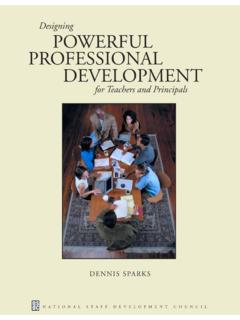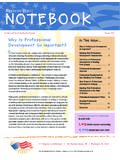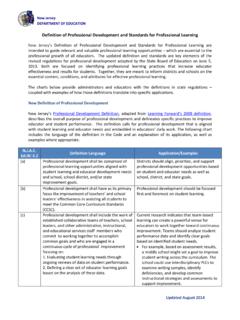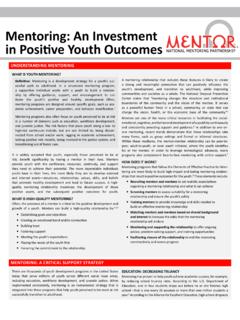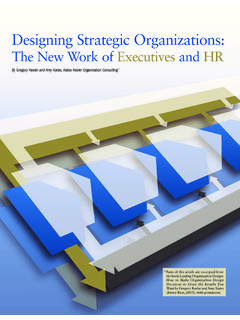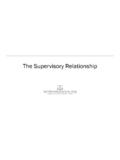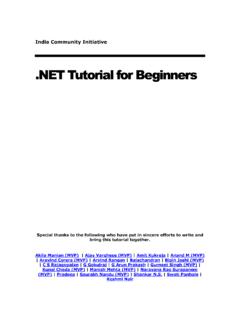Transcription of Systems of Practice: How Leaders Use Artifacts to Create ...
1 Running Head: Systems OF PRACTICE AND professional community . Systems of Practice: How Leaders Use Artifacts to Create professional community in Schools Richard R. Halverson University of Wisconsin Madison To be published in Education Policy Analysis Archives Abstract This article explores how local school Leaders construct the conditions for professional community in their schools. This paper argues that professional community is a special form of social capital that results, in part, from the design and implementation of facilitating structural networks by instructional Leaders in schools. The structural aspects of a school community can be conceived as a system of practice, that is, a network of structures, tasks and traditions that Create and facilitate the complex webs of practice in organizations.
2 Systems of practice are composed of networks of Artifacts , such as policies, programs and procedures, which can be seen as powerful tools used by local Leaders to influence local instructional practices. The system of practice framework suggests that Leaders use Artifacts to establish structures that facilitate the closure of professional networks among teachers, which in turns builds professional community . The leadership practices of an urban elementary school are used to illustrate how professional community has been developed through the selective design and implementation of Artifacts in order to reshape the local system of practice. Halverson: Systems of Practice 2. Please do not distribute without author's permission Systems of Practice: How Leaders Use Artifacts to Create professional community in Schools professional community is widely recognized as a valuable quality of local school contexts (Lee and Smith 1996; Little 1982; Seashore Louis and Marks 1996; Newmann and Wehlage, 1995).
3 This paper argues that professional community is generated by networks of trust and obligation developed among teachers and school Leaders around shared instructional practices in schools. Social capital is the accumulation of social values such as trustworthiness and respect as a result of participation in networks of social interaction, and resides in the relationships within an organization and between individuals (Driscoll and Kerchner 1988, 387-388). I argue that professional community is a form of social capital that results, in part, from the work of school Leaders to design and implement facilitating structural networks among teachers. The research presented here develops both conceptual tools to make relevant leadership practices visible and analytical tools to show how these practices, taken together, build this special form of social capital in schools.
4 The paper is organized into two main parts: a theoretical framework designed to capture the coherence and evolution of structures that result in professional community , and an illustration of how the framework is used to analyze leadership practices that developed social capital in an urban elementary school with a demonstrated high level of professional community . The theoretical framework proposed here explores how the structural aspects of a school community can be conceived as a system of practice. A system of practice is the network of structures, tasks and traditions that Create and facilitate the complex webs of Halverson: Systems of Practice 3. Please do not distribute without author's permission practice in organizations. Systems of practice refer to the structural constraints through which leadership, teaching and learning flow in a given school context (Ogawa and Bossert 1995).
5 School Leaders often introduce and maintain instructional change in schools through indirect means, such as the development and implementation of programs and policies, rather than through direct engagement with students. Here I. describe this indirect influence of Leaders on the local system of practice through the design and implementation of Artifacts . The term artifact, borrowed from human- computer interaction research ( Norman 1988; 1993), refers to entities designed to shape and enable organizational practices. When applied to understanding school leadership, Artifacts such as policies, programs and procedures can be seen as powerful tools used by local Leaders to influence and maintain instructional practices in schools. A. local system of practice refers to the network of Artifacts , taken together, that both shape the given context of instruction and point toward opportunities for school Leaders to alter instructional practices.
6 A system of practice provides a conceptual framework to explain how Leaders use, develop and selectively implement Artifacts to influence the practices of teaching and learning in schools. The study that comprises the second part of the paper profiles an urban school rated to have a high measure of professional community , and asks: 1) what are some of the key Artifacts that helped to shape the local system of practice? 2) how did these Artifacts evolve together, either by design or by coincidence, to shape the system of practice? and 3) how did the system of practice shape the professional community of the school? After identifying and discussing the development of three key Artifacts , I then use Coleman's (1988) concept of the closure of social Systems to show how these Artifacts , Halverson: Systems of Practice 4.
7 Please do not distribute without author's permission taken together, Create the conditions for professional community in the school. The analysis of how Leaders in a particular school developed, implemented and used Artifacts offers an interesting glimpse into how Leaders can Create Systems of practice that generate professional community , and how researchers and school Leaders can re-think their efforts to study and Create professional community in schools. professional Communities professional community provides a model for creating the conditions for teachers to hear, share and experiment with new ideas about practice. There has been considerable research on the character and effects of professional communities in schools. ( Louis, Kruse and Bryk 1995; Bryk, Camburn and Louis 1997; Newmann and Wehlage 1995, Youngs and King 2000; Supovitz and Poglinco 2000).
8 These researchers indicate that characteristics of schools with strong professional communities include: - a clear sense of shared purpose and collective responsibility for student learning;. - professional inquiry among staff to achieve that purpose, including opportunities for sustained collaboration and reflection on practice;. - deprivatization of teaching practice and norms of collegiality among teachers and Leaders ;. - opportunities for staff to influence school activities and policies. Strong professional communities in schools that promote collective responsibility for student learning and norms of collegiality among teachers have been associated with higher levels of student achievement (Lee and Smith 1996; Little 1982; Louis, Marks and Kruse 1996; Newmann and Wehlage 1995).
9 Halverson: Systems of Practice 5. Please do not distribute without author's permission While many schools have developed a sense of community among the adults, not all communities can be described as professional . A professional community is shaped around the goals that define teachers as members of a profession dedicated to promoting student learning (Grossman, Wineburg and Woolworth 2001). professional communities develop internal practices and expectations to coordinate the non-routine nature of teaching practice through self-regulation and the development of information feedback Systems (Louis, Kruse and Bryk, 1994; Huberman 1995; Little and Bird 1987; Argyris 1990). In professional communities, teachers have the opportunities to break down the isolation of classroom in collaborative, problem-setting and -solving activities with colleagues (Halverson 2002; Hargreaves 1994; Huberman 1995; Miller, Lord and Dorney 1994; Rosenholtz 1989).
10 These activities could include collaborative curriculum design, instructional evaluation, interdisciplinary teaming and curriculum development, textbook and course material review, or school improvement planning (Bryk, Rollow, and Pinnell, 1996). Networks of such activities help to Create and sustain the conditions for strong professional communities in schools. Although the value of professional community in schools is widely recognized, knowledge about how to Create and sustain professional communities is not as widely understood. Grossman, Wineburg and Woolworth's experience with developing professional community in a high school led them to comment: We have little sense of how teachers forge the bonds of community , struggle to maintain them, work through the inevitable conflicts of social relationships, and form structures for social relationships over time.

